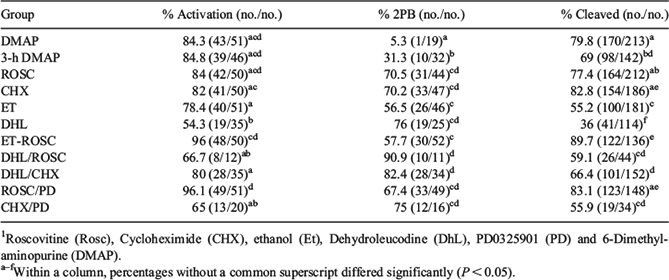188 HAPLOID ACTIVATION OF BOVINE OOCYTES WITH IONOMYCIN AND SINGLE OR COMBINED ACTIVATING AGENTS
M. Suvá A , N. G. Canel A and D. F. Salamone ALaboratorio de Biotecnología Animal, Facultad de Agronomía, Universidad de Buenos Aires, Buenos Aires, Argentina
Reproduction, Fertility and Development 28(2) 225-225 https://doi.org/10.1071/RDv28n2Ab188
Published: 3 December 2015
Abstract
Haploid activation of bovine oocytes is important for reproductive technologies such as intracytoplasmic sperm injection (ICSI) or somatic cell nuclear transfer (SCNT). Nevertheless, it is still a highly inefficient procedure. The aim of this work was to combine different activation drugs, known to have different targets along the activation cascade, to find a more effective activation protocol. Cumulus-oocyte complexes (COC) were aspirated from slaughtered ovaries and in vitro-matured (IVM) for 22 h. Oocytes were activated with 5 µM ionomycin (IO) for 4 min and then randomly allocated into 1 of the following treatments: 50 µM roscovitine (ROSC), 10 µg mL–1 cycloheximide (CHX), ROSC and 10 µM PD0325901 (ROSC/PD), or CHX and PD (CHX/PD) for 5 h; 15 µM dehydroleucodine (DHL) or DHL and ROSC (DHL/ROSC) for 3 h; DHL and CHX for 3 h followed by 2 h with CHX; 5-min exposure to 7% ethanol 4 h post-IO (ET); or ET followed by ROSC (ET-ROSC). Controls were IO followed by 3 h of exposure to 1.9 mM 6-DMAP with or without a previous 3-h culture in TCM-199 (3 h in DMAP and DMAP, respectively). Embryos were cultured in SOF medium. Pronuclear formation (PN) and second polar body extrusion (2PB) were assessed by 5 µg mL–1 propidium iodide oocyte staining, 17 h after IO. Activation was defined as the presence of at least 1 PN, and 2PB extrusion rate was calculated regardless of the nuclear stage. Data were analysed by Fisher’s Test (P < 0.05). Activation (Table 1) was similar in all groups, with the exception of ROSC/PD and ET-ROSC that were the highest and DHL that was the lowest. Although ROSC or CHX seemed to improve 2PB rate when combined with DHL, cleavage decreased significantly, suggesting DHL itself, or its combination with these drugs, negatively affects embryo development. Group ET showed activation rates comparable to other treatments, but it was not reflected on cleavage, suggesting that ET induces PN formation but it might be inefficient to trigger embryo development. Nevertheless, this observation was not made for ET-ROSC, as it showed a higher cleavage rate than ET and ROSC alone. The mitogen-activated protein kinase (MAPK) inhibitor PD showed different effects when combined with ROSC or CHX, despite that they both act on the mammary fat pad (MPF). In ROSC/PD, a slight improvement was observed on activation and cleavage rates compared with ROSC. Group CHX/PD resulted in a slightly higher 2PB percentage, but a lower activation percentage that derived in a significantly lower cleavage than CHX. In conclusion, ROSC and CHX were the most effective single treatments for haploid activation. Moreover, some combined treatments, namely DHL/ROSC and DHL/CHX, proved to be as effective or better at 2PB extrusion rate, which is the defining feature in haploid activation.

|


